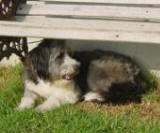Lack
of proper housetraining, and
subsequent housesoiling, is
a common cause for dogs to be
surrendered, and eventually
euthanized. The procedure is
quite simple, once you have
the knowledge on how to do it
correctly.
|
Remember - some dogs just take longer than
others, since they are all individuals
(just like some toddlers
potty train quicker than
others.) |
 Acceptance
of confinement is an excellent
gift to give any dog, and is
especially useful during elimination
training. Review how to kennel
train or use a tether as part
of elimination training.
Acceptance
of confinement is an excellent
gift to give any dog, and is
especially useful during elimination
training. Review how to kennel
train or use a tether as part
of elimination training.
Steps
To Canine Elimination Training
-
Confirm good health with a
physical exam by a veterinarian,
and lab tests if needed.
-
Give a high quality "Premium"
food on a fixed schedule.
Controlled in = controlled
out.
-
Give 3 meals per day until
3 months of age, then 2/day.
Pick up food and water
two hours before your bedtime
until trained. Give the puppy
an opportunity to eliminate
as the last thing before bedtime.
-
Use confinement and
supervision to prevent indoor
elimination. Use
a crate, 3 ft. tether or "umbilical
cording" (leash the
dog to you while indoors when
not crated or tied).
-
Know when the last elimination
occurred. Anticipate elimination
shortly after waking, play,
excitement, sniffing, and
meals. Dr. D. Fetco says:
puppies can hold their urine
approximately 1 hour more
than their age in months;
e.g., a 3-month pup can hold
urine 4 hours, a 5-month pup
can hold urine 6 hours, etc.
-
Define, for all family, a
proper "Doggy Toilet
Area" on your property.
Usually 8 X 8 feet.
-
Take the puppy outside hourly
the first day, then every
3-4 hours when you're
home.
-
Go out with your dog to backyard
toilet area. Use a leash at
first to keep him in the toilet
area.
-
Say, "Get busy!"
repeatedly until any elimination.
Praise and treat afterward.
-
After successful elimination,
allow freedom for gradually-increasing
periods of time. The dog should
begin to think the way to
get freedom and treats is
to deposit there.
-
Take plastic bags to parks,
and on walks. Give the "Get
busy!" Instruction
when any elimination posture
begins. Be responsible for
fecal clean-up.
-
Don't physically punish
accidents, since you will
want the dog to eliminate
in your presence in the future.
Verbal scolding is OK. Accidents
indicate more confinement
and that the owner needs to
pay more attention to this
process.
-
Use an odor neutralizer product
on accidents (available at
any pet store).
-
Give a BIG reward for proper
elimination.
 If
you must leave the dog along
for longer periods, do not use
the kennel, but instead use
a small room
like a laundry room or kitchen.
Use baby gates to keep the dog
confined. Move the kennel and
bed, chewtoy and water on one
end, and put
If
you must leave the dog along
for longer periods, do not use
the kennel, but instead use
a small room
like a laundry room or kitchen.
Use baby gates to keep the dog
confined. Move the kennel and
bed, chewtoy and water on one
end, and put  thicknesses
of newspaper on the floor on
the far other end. Don't
praise the dog for using the
paper unless you intend to "paper
train" long term. Just
take the dog out to the toilet
area before any greeting.
thicknesses
of newspaper on the floor on
the far other end. Don't
praise the dog for using the
paper unless you intend to "paper
train" long term. Just
take the dog out to the toilet
area before any greeting.
 Don't
let the dog watch you clean
up any indoor accident. Some
say if the pet sees you paying
attention to their contribution,
they may want to do it for you
again. Do let your dog see you
cleaning up the defined toilet
area, since this increases the
likelihood of eliminating there.
Don't
let the dog watch you clean
up any indoor accident. Some
say if the pet sees you paying
attention to their contribution,
they may want to do it for you
again. Do let your dog see you
cleaning up the defined toilet
area, since this increases the
likelihood of eliminating there.
Remember - some dogs just take longer than
others, since they are all individuals
(Just like some toddlers
potty train quicker than
others).
If not fully housetrained within
30 days, seek a behavioral consultation.